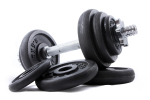- FreeTrainers.com Forums
- General Fitness & Exercise
- Spot Reduction, Lower Abs, Hi Reps Myths
Group: General Fitness & Exercise
Created: 2011/12/31,
Members: 383,
Messages: 54581
Various general exercise related discussions. Find out what it takes to reach your fitness goals through daily effective exercise. With so many options we try to find out what works best.
Join group
Spot Reduction, Lower Abs, Hi Reps Myths

mackfactor
Posts:
766
Joined: 2002/10/17  |
2003/01/24, 11:03 AM
Fat Loss & Weight Training Myths-------------------------------------------------------------------------------- Spot Reduction Myth Contrary to what the info commercials suggest, there is no such thing as spot reduction. Fat is lost throughout the body in a pattern dependent upon genetics, sex (hormones), and age. Overall body fat must be reduced to lose fat in any particular area. Although fat is lost or gained throughout the body, it seems the last area to become lean or the first area to get fat is the midsection (in men and some women) and hips and thighs (in women and few men). Sit-ups, crunches, hip raises, leg raises, hip adduction, hip abduction, etc. will only exercise the muscles under the fat. Incidentally, fat is also stored under the abdominal muscles and around the intestines and other organs. This can contribute to the "pot belly", pushing the abdominal muscles and the overlying fat outward. This "apple shape" fat distribution has greater health consequences than the lower body "pear shape" fat distribution. -------------------------------------------------------------------------------- Lower Abdominal Myth It is widely believe the lower abs are exercised during the leg raise or other hip flexor exercises. It can be misleading to judge the mechanics of an exercise based upon localized muscular fatigue. The primary muscle used in hip flexion is actually the Iliopsoas, one of many hip flexors. The Iliopsoas, indeed, does happen to originate deep below the lower portion of the Rectus Abdominis. During the leg raise the entire abdominal musculature isometrically contracts (contracts with no significant movement) to: Posture the spine and pelvis Supports the weight of the lower body so the lumbar spine does not hyperextend excessively Maintains optimal biomechanics of the Iliopsoas Hips are kept from prematurely flexing if the lumbar spine and pelvis does not hyperextend excessively Iliopsoas can contract more forcefully in a relatively slight stretched position Bent knee (and hip) situps actually place Iliopsoas in a mechanical disadvantage Counteracts Ilopsoas's pull on spine Many people with weak abdominal muscles are not able to perform hip flexor exercises without acute lower back pain or discomfort The combination of the local muscular fatigue, or a burning sensation from the isometrically contracted abdominal muscles, and from the working hip flexors produces fatigue in the pelvis area which we mistakenly interpret as the lower portion of the Rectus Abdominis being exercised. In movements where the Rectus Abdominis does Isotonically contract (contracts with movement), it flexes the spine by contracting the entire muscle from origin to insertion. The spine is not significantly flexed during the leg raise. Incidentally, both the spine and hip flexes during the Sit Up and Hip Raise. See Spot Reduction Myth above. -------------------------------------------------------------------------------- High Repetitions Burn More Fat Myth Performing lighter weight with more repetitions (15-20 reps, 20-30 reps, or 20-50 reps) does not burn more fat or tone (simultaneous decrease of fat and increase muscle) better than a heaver weight with moderate repetitions (8-12 reps). Weight training utilizes carbohydrates after the initial ATP and CP stores have been exhausted after the first few seconds of intense muscular contraction. Typically a set's duration is 20 to 30 seconds. For the average fit person, it requires 20 to 30 minutes of continuous aerobic activity with large muscle groups (eg. Gluteus Maximus and Quadriceps) to burn even 50% fat; fat requires oxygen to burn. Performing a few extra repetitions on a weight training exercise is not significant enough to burn extra fat and may in effect burn less fat. If intensity is compromised, less fat may be burned when light weight is used with high repetitions. The burning sensation associated with high repetition training seems to be the primary deterrent for achieving higher intensities. For individuals attempting to achieve fat loss for aesthetics, the intensity of weight training can be a double edge sword. When beginning an exercise program, muscle mass increases may out pace fat losses, resulting in a small initial weight gain. Significant fat loss requires a certain intensity, duration, and frequency that novice exercisers may not be able to achieve until they develop greater tolerance to exercise. If an exercise and nutrition program is not adequate for significant fat loss, a lighter weight with higher repetitions may be recommended to minimize any bulking effects, although less fat may be utilized hours later. If an aerobic exercise and nutrition program is sufficient enough to lose fat, a moderate repetition range with a progressively heavier weight will accelerate fat loss with a toning effect. If a muscle group ever out paces fat loss, the bulking effect is only temporary. For a toning effect, fat can be lost later when aerobic exercise can be significantly increased or the weight training exercise(s) for that particular muscle can be ceased altogether. The muscle will atrophy to a pre-exercise girth within months. Higher repetitions training may be later implemented and assessed. It still may be recommended to perform high repetitions (20-30 or 20-50 reps) for abdominal and oblique training. With fat around the waist, moderate repetitions with a greater resistance can increase muscular girth under the subcutaneous fat. If fat is not lost, more muscle can push out the fat resulting in a bulkier appearance. The abdominal muscles are relatively small muscles. Performing high reps with a lighter resistance will not compromise metabolism or muscle increases as would performing high reps with light resistance on larger muscles. See Spot Reduction Myth above. It is plausible that the high repetition myth was originated and later propagated by bodybuilders that used calorie restrictive diets to shed fat before a contest. Because of their weakened state from dieting, they were unable to use their usual heavier weights. When inquired about their use of lighter weights, they explained they were "cutting up" for a contest. This is merely a theory, but it is easy to see how it may have been misunderstood that the lighter weight was used to reduce fat instead of actually being a result of their dietary regime. www.exrx.net ---------------------------- "Don't follow leaders and watch your parking meters!" -- Bob Dylan |
|
| |

mackfactor
Posts:
766
Joined: 2002/10/17  |
2003/01/24, 11:12 AM
As an aside, I'm not entirely sure about the last myth regarding high rep training. To me it would make sense that one would burn more calories on light weight, high repitition training due to the mere fact that with those extra reps you can move more total weight. If you can bench 150 about 10 times, chances are when you drop the weight to 115, you can crank out 20, meaning that you do more total work (in the scientific sense).I also disagree that low rep ab work is the best way to go. I think the abs, just as with any muscle group, should be exposed to a variety of rep schemes, not just high rep training all the time. -------------- "Don't follow leaders and watch your parking meters!" -- Bob Dylan |

bb1fit
Posts:
11,105
Joined: 2001/06/30  |
2003/01/24, 11:20 AM
I disagree with you on the high rep post. For one, think of the long term. If you start decreasing your weights, sure, you can maybe do more "work", but you are actually setting your self up for muscle loss, which in the long run, decreases your metabolic fat burning "furnace", which works on a 24 hr. a day basis.-------------- Failing to plan is like planning to fail! |

rev8ball
Posts:
3,081
Joined: 2001/12/27  |
2003/01/24, 11:44 AM
A lil of both, mack. The amount of weight does matter alot, especially when taken into account the amount of muscle mass the person may have. For example, say you have a strongman who's max bench is 725, and he weighs in at around 300. A warm up for him could easily be 315 for reps. But let's say, he now wants to cut back a some on the BF %, so he cycles in some more cardio and higher reps/lower weight schemes. The concept of doing more total work by just the fact of doing more reps regardless of weight doesn't apply. In other words, would 20 reps of 135 lbs do jack for this guy? No.At the same time, though the article is correct with it's analysis of how muscles burn energy, and that is why it's not necessary to do high reps, it falls short of the true concept as well. The idea of the higher rep regimen is used not only to get the body's muscles to work, but to get the heart rate up as well, and make the lifting more cardio. The higher rep scheme is not meant to be done at the same rate of low rep/high rep tempo, such as a 1,2 tempo, but at a faster rythem, in order to keep the heart pumping. So, as you can see, the idea of work and burning kcals is not really one or the other. An amount of weight is needed in order to get the muscles to burn some cals while actually doing some work, and even getting a some growth as well, while the speed is needed in order to get the heart involved. Hope that helps....... -------------- Michael "Trample the weak; hurdle the dead!" |
